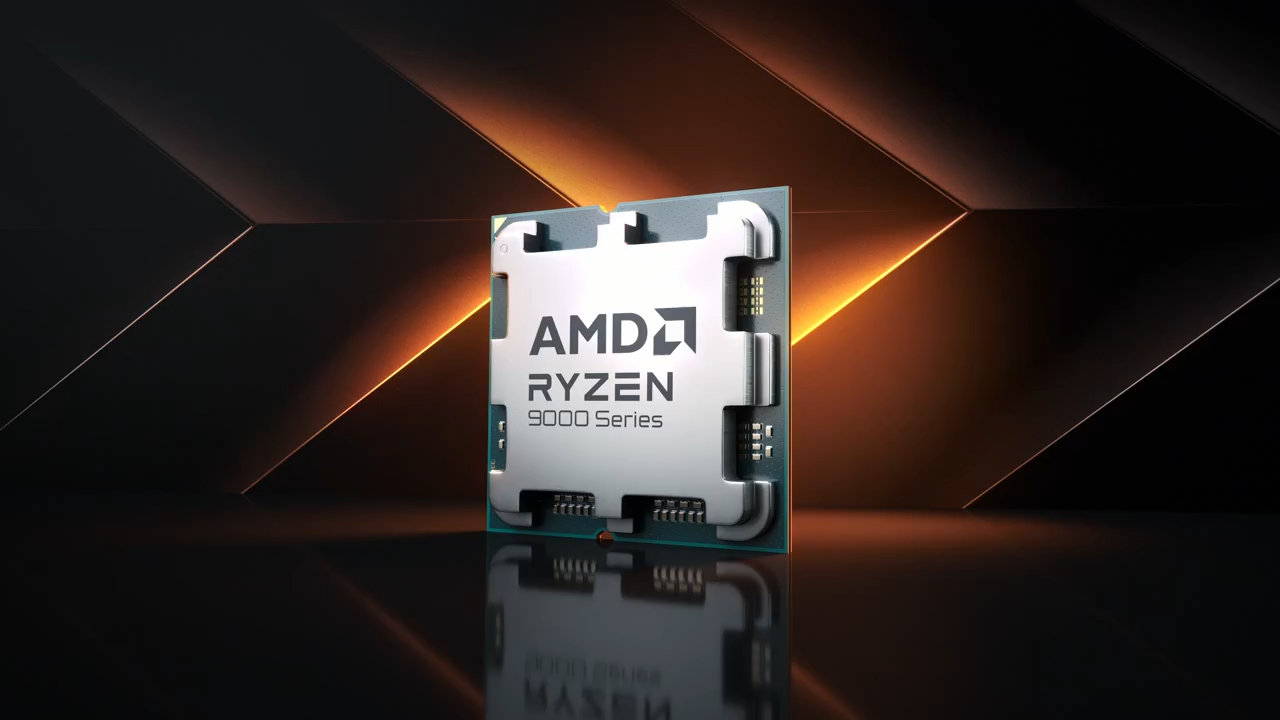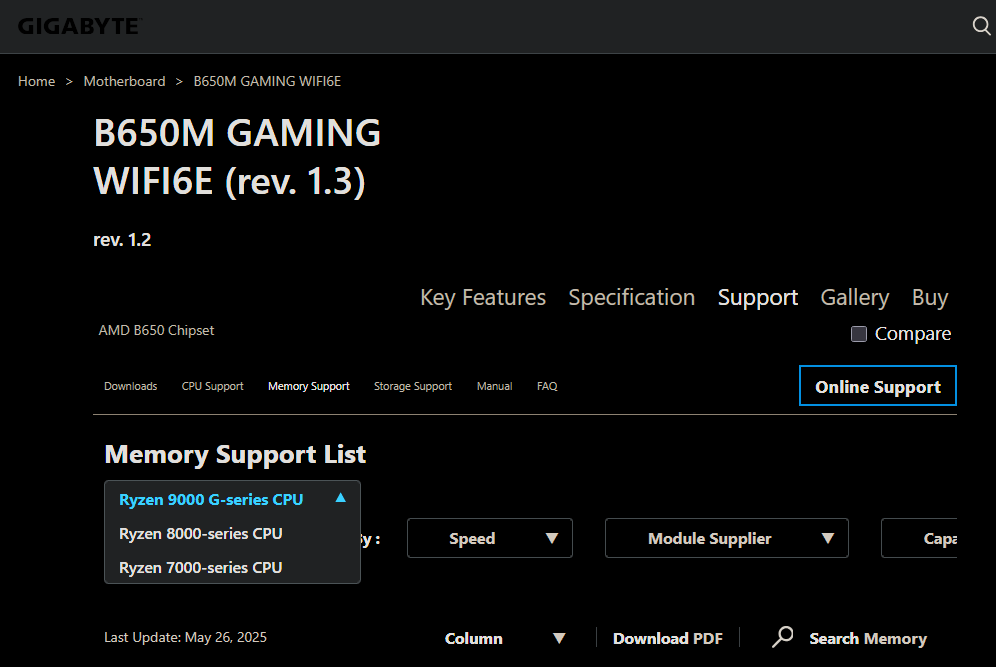Gigabyte hints AMD's next-gen gaming APUs will drop into current-gen motherboards — Ryzen 9000G support listed for AM5 platforms

One of Gigabyte's B650 (AM5) motherboards now lists support for AMD's unreleased and likely soon-to-launch Ryzen 9000G series APUs, as reported by VideoCardz. This suggests that AMD's upcoming Ryzen 9000G APUs will probably be supported on existing 600 and 800 series motherboards, of course, with a necessary BIOS update. That being said, names, specifications, and pricing still remain unconfirmed.
We first heard of AMD's Ryzen 9000G processors in late March, with leakers suggesting they'd employ Gorgon Point silicon. These APUs succeed AMD's incumbent Phoenix-built Ryzen 8000G lineup, which first debuted in January 2024. As for the underlying silicon, there are some nuances since Gorgon Point is rumored to be a refresh of Strix Point (Ryzen AI 300), alleged to offer single-digit performance increments across the board.
Gigabyte has inadvertently published a list of supported memory modules for unreleased Ryzen 9000G APUs on its B650M GAMING WIFI6E motherboard. This marks the second unofficial confirmation that these APUs will slot into existing AM5 motherboards. Nothing is official until AMD gives the official green light, so we'll still mark this as a leak.

In terms of expected specifications, we're looking at up to 12 hybrid cores (4x Zen 5 + 8x Zen 5c) / 24 threads, a 16 Compute Unit equipped graphics engine based on RDNA 3.5, and an XDNA 2 based NPU that can dish out between 50-55 TOPS of AI performance. As such, these could be in the running to power the first desktop Copilot+ PCs, if that badge matters to you. Additionally, leaks suggest a Q4 2025 release timeline for these processors, which is several months off.
Gorgon Point has several tiers (GorgonPoint1, GorgonPoint2, and GorgonPoint3) based on a previous leak. Some of these dies may be recycled further down the stack as Krackan Point silicon. Still, these are just technical nuances as most of these dies are quite similar in terms of features, unlike Phoenix1 and Phoenix2, the latter of which lacked an NPU. This raises the question of whether AMD will scale Krackan even further down to dies that lack NPUs or shift to a monolithic core design.
Follow Tom's Hardware on Google News to get our up-to-date news, analysis, and reviews in your feeds. Make sure to click the Follow button.
Get Tom's Hardware's best news and in-depth reviews, straight to your inbox.

Hassam Nasir is a die-hard hardware enthusiast with years of experience as a tech editor and writer, focusing on detailed CPU comparisons and general hardware news. When he’s not working, you’ll find him bending tubes for his ever-evolving custom water-loop gaming rig or benchmarking the latest CPUs and GPUs just for fun.
-
philipemaciel A bit disappointed that the upcoming chips will have a so-called "NPU". Why waste silicon with a "feature" no one wantsReply -
LaminarFlow Currently I have a 8500G running my NAS on an A620 MB. While a 9000G APU seems completely unnecessary, it does get me interested as I start to throw more demanding tasks at it.Reply
Here's to hope it comes with one with decently low power profile and notable performance bump. I don't care about anything AI, but if it comes with below 50W typical power requirement (8500G normally tops out at ~45W), I'll keep my eyes peeled. -
usertests Reply
You have the very compromised Phoenix2 model.LaminarFlow said:Here's to hope it comes with one with decently low power profile and notable performance bump. I don't care about anything AI, but if it comes with below 50W typical power requirement (8500G normally tops out at ~45W), I'll keep my eyes peeled.
If Krackan becomes a cheap replacement for 8500G/8300G, it could be pretty interesting. 4+4 cores (from 2+4), 8 CUs (from 4). Not sure about PCIe lanes and such.
Better get over it.philipemaciel said:A bit disappointed that the upcoming chips will have a so-called "NPU". Why waste silicon with a "feature" no one wants -
Notton If these are Strix Point APUs, then it's highest config would be 12 (Zen5x4+ Zen5Cx8) Core, 16CUReply
But if these are Strix Point, how do they intend to address the lack of PCIe lanes?
Granite Ridge (9000 series) has 24x 5.0
Strix Point has 16x4.0
Also, if the Ryzen HX 3xx mini-PCs are any indication to go off of, the 9000G will see a substantial price increase compared to previous gen. -
thestryker Reply
AMD's APUs are always just laptop chips so even if the NPU wasn't functionally there it would be taking up silicon just the same.philipemaciel said:A bit disappointed that the upcoming chips will have a so-called "NPU". Why waste silicon with a "feature" no one wants -
thestryker Reply
There's no way for them to do so. I'd expect it will be just like the lower SKUs of Phoenix Point and they'll just have less connectivity. All of the Zen 5 APUs do have the same lane count so I guess that makes it less bad for the stack as a whole, but still means PCIe 4.0 x8 for that primary slot.Notton said:But if these are Strix Point, how do they intend to address the lack of PCIe lanes?
It will depend on which APUs AMD opts to use for the desktop versions. I wouldn't be surprised if that tier was the 8 core (4x Z5/4x Z5C) version though and there would be 2 more usable PCIe lanes so it could be a decent upgrade if youre using the capability.LaminarFlow said:Currently I have a 8500G running my NAS on an A620 MB. While a 9000G APU seems completely unnecessary, it does get me interested as I start to throw more demanding tasks at it.
Here's to hope it comes with one with decently low power profile and notable performance bump. I don't care about anything AI, but if it comes with below 50W typical power requirement (8500G normally tops out at ~45W), I'll keep my eyes peeled. -
DS426 Reply
Because it's already there since it's a refresh of Strix Point, plus AMD wants the marketability of the "Copilot+ PC", even if most of us don't care about that label. Some people do like the idea of running some low-end AI tasks locally on their PC, which isn't just about chat LLM's but other software features and capabilities that make more sense or aren't possible at all with traditional hard cording. NPU's are already utilized in some apps (not just Windows crap), with the use-cases only growing.philipemaciel said:A bit disappointed that the upcoming chips will have a so-called "NPU". Why waste silicon with a "feature" no one wants
Like it or not but NPU's are here to stay on mobile CPU's and APU's. Remember that TDP limits performance more than anything on these chips, not die sizes -- same reason why you don't have 16 full-fat Zen cores and as high base and turbo clocks of desktop Zen (and same with Intel). -
Loadedaxe Reply
NPUs might seem unnecessary if you're not using AI features regularly. But they actually serve a purpose beyond just hype. NPUs are optimized for handling machine learning tasks efficiently, which can free up CPU and GPU resources and improve overall system performance.philipemaciel said:A bit disappointed that the upcoming chips will have a so-called "NPU". Why waste silicon with a "feature" no one wants
Even if you're not running AI apps directly, background processes like image enhancement, speech recognition, or even battery optimization can benefit. It's about future-proofing too, as more software integrates on-device AI, having dedicated hardware can make a real difference in speed and efficiency.